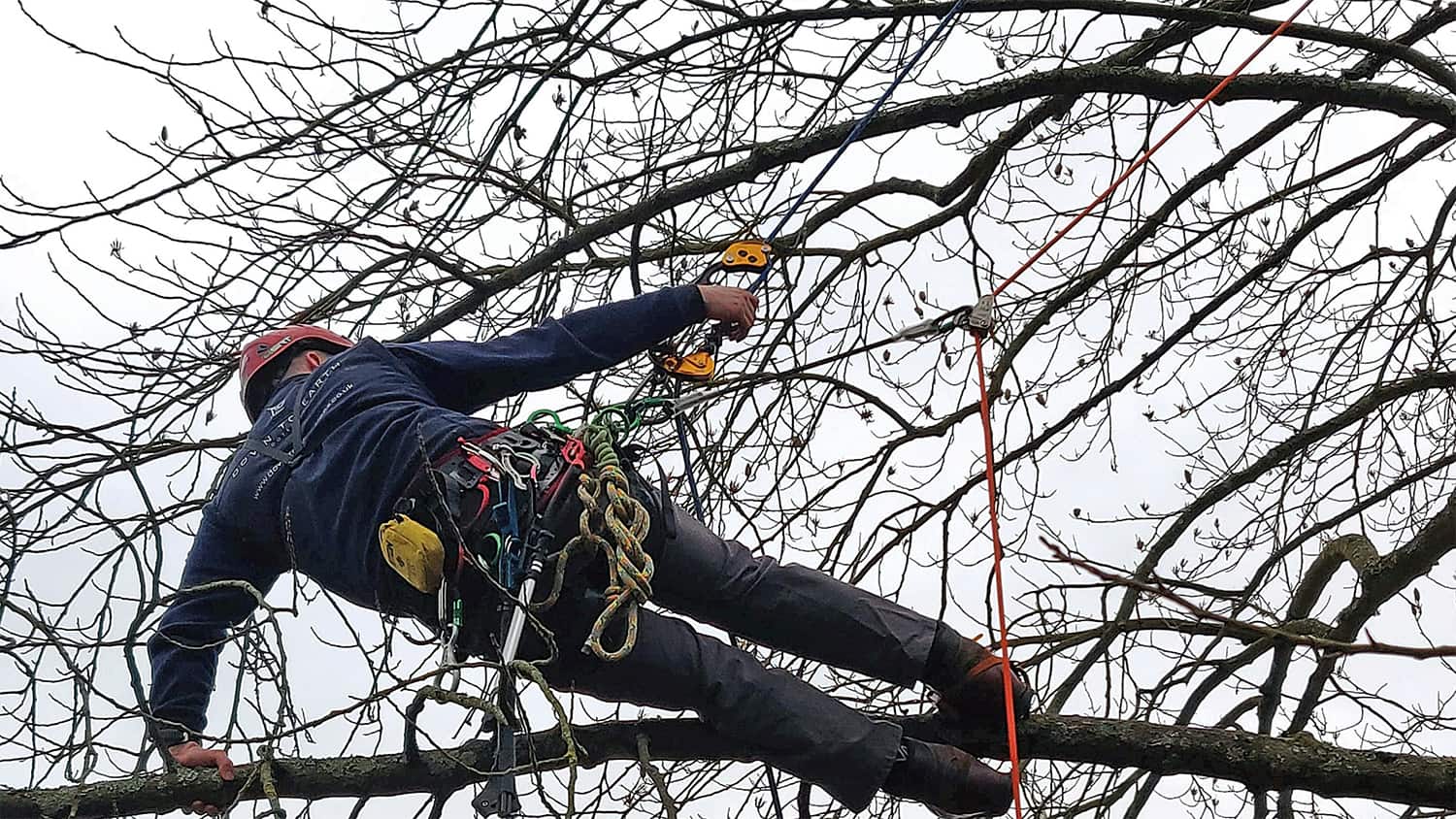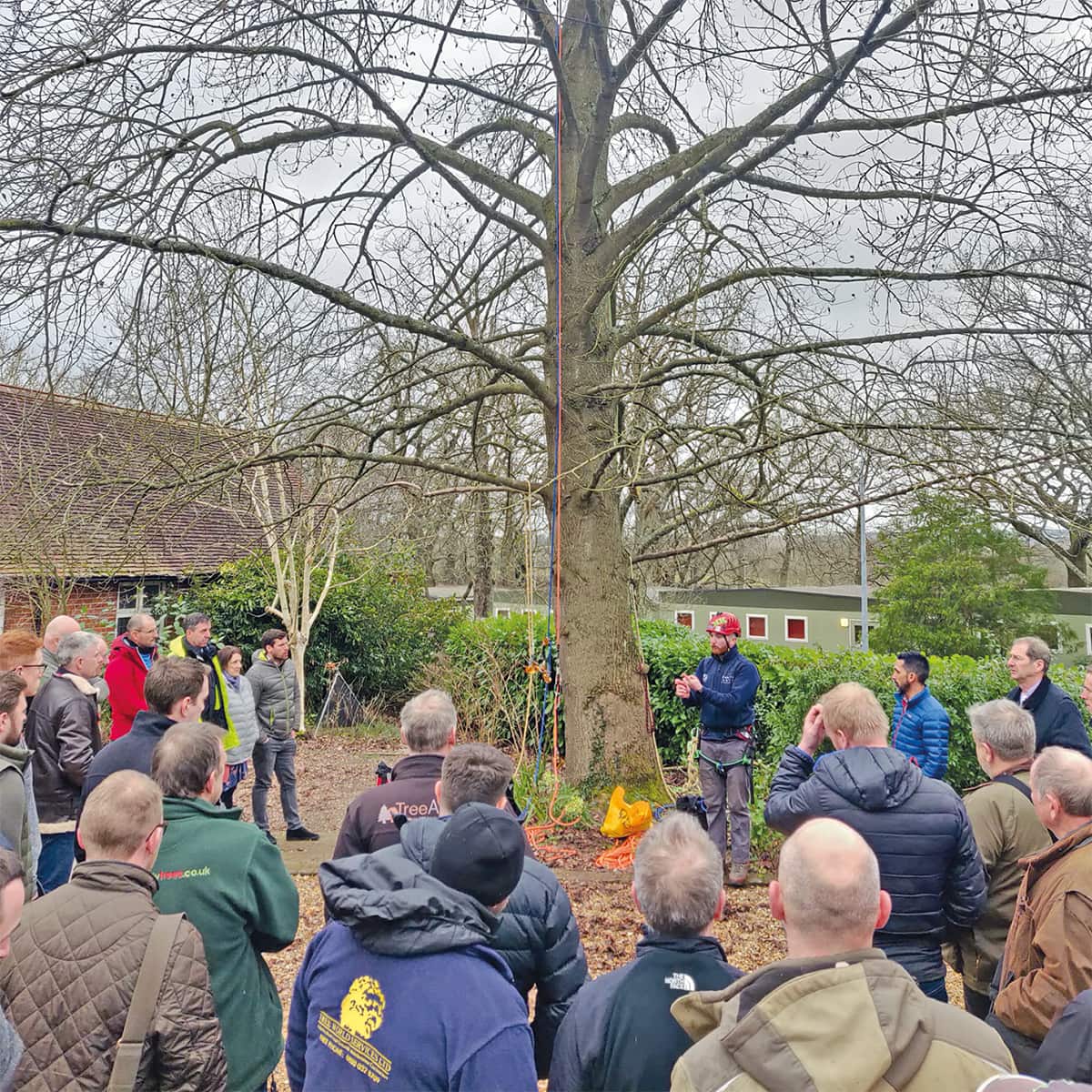Industry Code of Practice Consultation

Aran Harris demonstrates the use of a backup system.
The industry consultation on the revisions to the Association’s Industry Code of Practice for Arboriculture – Tree Work at Height (ICoP) closed on 17 January. Thank you to the nearly 200 people who responded with their constructive comments and suggestions for improvements. We’ve been working through this feedback and can incorporate many of the helpful and constructive ideas to improve clarity, include technical amendments and ensure the flow of the document is logical and the content comprehensive.
Many comments requested that more technical detail should be provided, but of course the ICoP is intended to deal with policy, principles and protocols, to support those responsible for planning, management and supervision of safe tree work activities; it is not intended to offer detailed, technical guidance to operators – that will come in the forthcoming Technical Guides.
However, by far the greatest number of comments received were in relation to the issue of using two ropes or, to be more accurate, a primary system and a backup, as required by the Work at Height Regulations. We received over 100 detailed written comments on this subject, which was presented in section 2.9 in the draft for consultation. In addition to this, I have personally received many emails on this subject. In collating these responses, we have been able to identify a number of different key messages and opinions (in no particular order):
- As an industry we need to improve safety.
- The Work at Height Regulations set legal requirements that must be complied with.
- The terminology used in the draft of section 2.9 to explain compliance is highly complex and confusing.
- There will be no overall increase in safety as a result of the implementation of these guidelines and there is the potential for introducing greater risk.
- Given the nature of the industry, only larger and compliant contractors will adopt the required standards and therefore the ‘uneven playing field’ will become more uneven, potentially putting some contractors out of business if they are no longer able to compete commercially with non-compliant contractors.
- There are more important aspects that the industry needs to address, namely training, consolidation and supervision, to create a professional, safe industry sector.
There were, of course, many other detailed comments and remarks which will all be taken into account in our revision of the ICoP.
In addition to the normal consultation responses, the Association also received a list of the signatories to a petition that has been circulating the industry. At the time of receipt, there were over 6,000 signatories.
All our consultation responses and the petition were forwarded to the Health and Safety Executive (HSE) for its consideration.
Stakeholder engagement
The Association has been reaching out to many different stakeholders in, and outside, our industry sector, to ensure a broad and comprehensive consultation process. One of the most informative meetings we had was with the Industrial Rope Access Trade Association (IRATA), who invited us to discuss the current issues with a range of highly experienced and knowledgeable work at height specialists.
This presented three significant conclusions:
- The principle of working with a primary personal fall protection system and a backup is completely established in industrial work at height, and the current working practices adopted by the tree work industry since 2005 are an obvious exception.
- Those present recognised that the range of climbing systems that we use in tree work do not naturally fit neatly with any one system of personal fall protection as described in the Work at Height Regulations.
- There is a commercial interest from work at height manufacturers and suppliers in helping to research and develop equipment to help the arboricultural industry sector meet its needs.

Aran Harris, of Down to Earth Trees, introduces the practical sessions at Merrist Wood College.
This led to a change in our approach to the subject, and the terminology, of ‘two-rope working’ in the ICoP (click here for more). Firstly, there is no requirement in the Regulations for climbers always to have two complete rope systems; while this may work well for certain jobs in certain trees, it will be impractical in many circumstances. What is required is that there must be some form of backup, to prevent the climber falling if the primary system were to fail. This ‘backup’ could comprise an adjustable lanyard, a flip line if working on a stem, the other end of the rope or a purpose-designed backup system developed for tree climbing work.
Taking on board IRATA’s suggestion that we should ‘take ownership’ of our approach to safe working and compliant practice for our industry sector, we have introduced a significant shift in the ICoP document; section 2.9 has now been removed altogether and arboricultural work at height is presented as a range of techniques that sit under ‘Personal Fall Protection Systems’. This allows us to avoid getting drawn into the semantics and complexity of further defining individual techniques, while still remaining fully compliant with the Regulations.
A new section 2.8.6 starts with a ‘narrative’ introduction:
‘Trees, by their nature, are all different; they are three-dimensional, organic structures. The personal fall protection systems used in other work at height sectors do not individually meet the needs of climbing arborists and may only apply in certain, limited, circumstances. By contrast, tree climbing involves a variety and flexible range of different systems and techniques brought together to achieve safe and efficient working systems.’
However, there is no getting away from the basic requirement (click here for more):
‘When using personal fall protection systems for tree climbing, it is expected that there will be a backup system to prevent the climber falling if the primary system, including main line, components or anchor, were to fail. The backup must be attached to an independent anchor where possible, or otherwise attached to a shared anchor.
‘Any personal fall protection anchor must be unquestionably reliable and be capable of withstanding any foreseeable loading, taking into consideration all environmental conditions, potential failure modes and system configurations.’
The HSE has responded to this approach very positively, and at a meeting on 4 February at Merrist Wood College, a wide range of industry representatives, including contractors, manufacturers, suppliers, trainers, AA staff, the HSE, the Utility Arboriculture Group, the AA’s Chair and Trustees, met to discuss the issue. (See page 73 of the ARB Magazine, Spring Issue 188, for Navin Sehmi’s report on the meeting and the wider issues.) The new approach was presented to a generally warm reception all round. However, as always there is ‘devil in the detail’ and there is still much work to do before we can present detailed guidance on safe, practical and compliant methods.
As we take the process forward, we are also identifying specific operational situations where it may be necessary and acceptable to omit the second, or backup, system, for short duration tasks. The HSE is currently working with us to agree these examples and these will be detailed in the forthcoming Technical Guide: Tree Climbing and Aerial Rescue (TG1).
One of the keys to this challenge will be recognising the very wide range of different circumstances we work in, including tree size, species, form, location and setting, and the arboricultural objectives that we have to address: there can never be a ‘one size fits all’ solution. Indeed, climbing may often not be the most appropriate method to carry out the work, as the ‘Risk hierarchy for tree work at height’ sets out in the ICoP.
While the HSE has made it clear that it expects tree climbing operations to be carried out conforming to the existing Work at Height Regulations, considerable concern has been expressed, through the consultation process and elsewhere, that there is the potential for increased risk if operators start to experiment with techniques and equipment that is not yet proven or approved. The AA has therefore issued the following statement:
‘Until detailed guidance becomes available, the Arboricultural Association recommends climbers continue to climb following current safe practice, using 2 lines wherever practical but without trialling techniques and equipment which are unproven. The safety of our workforce should remain everybody’s priority.’
Full ICOP Consultation Update
What next?
The detailed work of considering all of the ICoP consultation responses and re-drafting the relevant sections with the appropriate amendments will take a little time; it is most important that this authoritative document reflects safe, efficient and effective practice for tree work at height, from the first principles of planning and preparation through to implementation by an adequately trained, competent workforce, using equipment that is fit for purpose, suitable and compatible.
We envisage the revised ICoP being published in April 2020 as a ‘free-to-download’ PDF document, to be followed by the draft Technical Guide 1 which, after a further full consultation process, will be published in the summer.
We are already making plans for dissemination of the revised guidance, working with partner stakeholders to offer update workshops around the UK during the summer; more details of these events will be made available over the next couple of months.
This article was taken form Issue 188 Spring 2020 of the ARB Magazine, which is available to view free to members by simply logging in to the website and viewing your profile area.